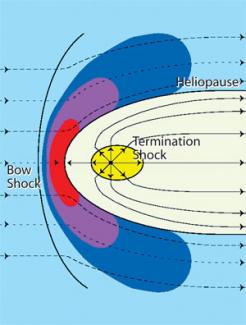We know a lot about cool stars because our Sun is one of them. However, we can't know for sure if cool stars produce winds (like the Sun does) without looking for evidence of such winds. Where stellar winds exist, they interact with hydrogen in the interstellar medium far from the star to produce tell-tale absorption in stellar ultraviolet spectral lines. The solar wind produces a similar spectral signature from interactions that occur hundreds of times further from the Sun than the Earth. The interactions are strongest in the hot, dense (red) region shown between the heliopause and the bow shock in the diagram on the right.
By analyzing data from the Hubble Space Telescope, Senior Research Associate Brian Wood, Fellow Jeff Linsky, and their colleagues have detected winds for 13 nearby cool stars. By combining their observations with computer modeling, they've been able to deduce how the strength of stellar winds varies with the age of the star and the X-ray luminosity of their coronae.
When cool stars are young, they tend to rotate rapidly, creating magnetic fields that produce starspots (sunspots) and very hot coronae, whose temperatures can range from 1-10 million °C. Thermal expansion of the hot corona creates the stellar wind. Up to a point, the more active the star, the stronger the stellar wind it creates. However, if a very young star rotates fast enough to create starspots all over its surface, including at the poles, then magnetic forces around that star appear to inhibit the hot corona from expanding out from the star. This effect leads to weaker winds.
Studies of stellar winds have led Wood and his colleagues to suggest that the Sun probably had a modest solar wind for its first 700 million years. Then when the Sun's rotation slowed enough for its polar sunspots to disappear, the strength of the solar wind increased dramatically. Since then, the Sun's magnetic fields have continued to slow its rotation, calming down coronal activity and reducing the solar wind to current levels.
Wood says the evolution of the solar wind with time may help explain one of the solar system's great mysteries: What happened to the atmosphere of Mars? Observational evidence suggests that when Mars formed, it had a much thicker atmosphere. Evidence also indicates that in the distant past, Mars' denser atmosphere eroded away - around the time the strong solar wind first appeared. In a sense, Mars' atmosphere may have fallen victim to a perfect storm. Just before the advent of the strong solar wind, the planet's molten core had cooled and solidified, eliminating the magnetic shield that could have protected it. Luckily for us, the larger planet Earth retained its molten core (and protective magnetic field), enabling it to hold onto its atmosphere then and for billions of years afterwards.
The research reported here appeared in the July 2005 issue of the Astrophysical Journal Supplement Series and the August 1, 2005, issue of the Astrophysical Journal. - Julie Phillips



 The Physics Frontiers Centers (PFC) program supports university-based centers and institutes where the collective efforts of a larger group of individuals can enable transformational advances in the most promising research areas. The program is designed to foster major breakthroughs at the intellectual frontiers of physics by providing needed resources such as combinations of talents, skills, disciplines, and/or specialized infrastructure, not usually available to individual investigators or small groups, in an environment in which the collective efforts of the larger group can be shown to be seminal to promoting significant progress in the science and the education of students. PFCs also include creative, substantive activities aimed at enhancing education, broadening participation of traditionally underrepresented groups, and outreach to the scientific community and general public.
The Physics Frontiers Centers (PFC) program supports university-based centers and institutes where the collective efforts of a larger group of individuals can enable transformational advances in the most promising research areas. The program is designed to foster major breakthroughs at the intellectual frontiers of physics by providing needed resources such as combinations of talents, skills, disciplines, and/or specialized infrastructure, not usually available to individual investigators or small groups, in an environment in which the collective efforts of the larger group can be shown to be seminal to promoting significant progress in the science and the education of students. PFCs also include creative, substantive activities aimed at enhancing education, broadening participation of traditionally underrepresented groups, and outreach to the scientific community and general public.